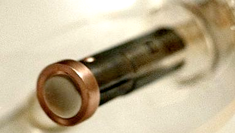“Free anti-cathode” High Frequency Tube
Ref. B15



This is a high frequency tube, 18” (45 cm) long and 6” (15 cm) bulb of unknown make. It dates back to the 2nd decade or early twenties of the last century.
Essentially similar in design to the “Kesselring” free anti-cathode ion tube, but without the small funnel-shaped copper attachment on the rear of the anti-cathode, and the presence of a black metal jacket around and behind the strongly discoloured aluminium cathode cup.
There is no external electrical connection to the anti-cathode. The anti-cathode tungsten target is so placed as to intercept the path of the electron beam flowing from the cathode towards the anode, and X-rays are produced by the impact of the electron beam on the target.
Regeneration is performed through the short carbon-like black rod in the secondary glass chamber communicating with the upper side of the tube bulb.
Picture of a resembling high frequency tube, signed “Macalaster & Wiggin Co”. Note the absence of the black metal backing of the cathode.
“A good method of regeneration consists in putting a piece of carbonaceous material in an accessory chamber and mounted on a wire communicating with a terminal outside. The regeneration is automatic and by setting the hinged wire at any given distance from the cathode end, the tube will regenerate itself to the vacuum corresponding to that distance, for as the resistance of the path between the proper electrodes increases, current passes around through the regulator down the wire and jumps across to the negative end liberating a minute quantity of gas from the regeneration material, and the vacuum is lowered”.
( E.R. Morton –“ A Text-Book of Radiology”, 1918, p.43.)